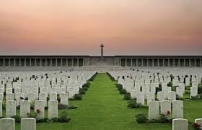| First Name: | John | Last Name: | O'BRIEN | |
|---|---|---|---|---|
| Date of Death: | 21/03/1918 | Lived/Born In: | East Sheen | |
| Rank: | Regimental Sergeant Major | Unit: | London2/4 | |
| Memorial Site: | 1. Isleworth Memorial 2. Pozieres Memorial, France | |||
Current Information:Age-36 Distinguished Conduct Medal 87, Sheen Lane, East Sheen
The German offensive of 21st March, 1918 With an end to the fighting on the Eastern Front after the Russian Revolution, Germany was able to bring its troops from there to France and launch a series of offensives in the Spring of 1918, designed to bring the war to a swift conclusion. Four times between March and July they attacked in strength and on each occasion they broke through the British and French lines and made spectacular gains but in each case they over extended themselves and without adequate supplies keeping up with their rapid advances, they could go no further.The first of these attacks, Operation Michael, was made on 21st March by 63 specially trained divisions, attacking along a 60 mile front held by 26 British divisions, many of them in a weakened state At 4.40am the German artillery opened up with the most ferocious and concentrated bombardment of the war, the likes of which the British had never experienced before. The Forward Zone, consisting mainly of individual posts was blown away. Very few of the men there made it back. Many were killed and many more were taken prisoner. The Battle Zone was also battered as were the British guns, firing from positions just to the rear. Brigade and Divisional HQs were targeted as well and then, from out of the thick mist came the German storm troopers. Moving fast, they skirted round the few remaining strongholds and penetrated deep into the British lines, including those of the Battle Zone, causing the utmost confusion. There were many cases of heroic stands being made but the relentless pressure forced the British back everywhere and there then began a general retreat that went on for two weeks and which ceded to the Germans a huge amount of territory, including all of that that had been won at such great cost during the Battle of the Somme in 1916. On 21st March, 58th Division held the extreme south of the British line, facing the village of La Fère with two brigades south of the River Oise, neither of which were attacked. It was a different story for 173 Brigade, holding a three mile front north of the Oise. At 6.10am, after a ferocious artillery barrage, the German infantry advanced against the Forward Zone held by 2/2nd London in a series of small posts hundreds of yards apart and by 9am, with the fog still thick, many of these were heavily engaged. Despite stout resistance by 2/2nd London these posts had all been overcome by midday and there was not much left of the battalion. 2/4th London had moved up to the canal bank at Fargniers in the Battle Zone the night before and as the day progressed they became more and more involved in the battle. Just after midday they beat off a German advance against part of 18th Division line to their left and were then reinforced by 182nd Tunnelling Company and half of the 3rd London battalion from reserve. There was fierce fighting until after dark and at one stage the enemy entered Fargniers but 2/4th London and 3rd London, with the help of artillery, forced them out. Two platoons of 3rd London were also sent to reinforce Ferme Rouge, north-east of Quessy. By late afternoon the enemy were still being held but 2/4th London were then ordered to withdraw to the other side of the St Quentin Canal to conform with a withdrawal on their left. By midnight 2/4th London were in positions on the rear edge of the Battle Zone around Quessy. There had been many casualties among the three battalions of 173 Brigade including John O’Brien of 2/4th London. |
||||
| « Back to Search Results | ||||
| If you think any of the information shown here is incorrect, Click Here to submit your amends and comments | ||||




